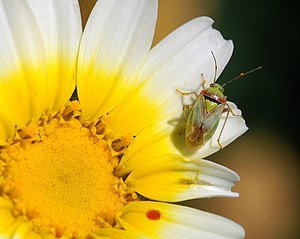Lygus maritimus
| Lygus maritimus | ||||||||||||
|---|---|---|---|---|---|---|---|---|---|---|---|---|

Lygus cf. maritimus |
||||||||||||
| Systematics | ||||||||||||
|
||||||||||||
| Scientific name | ||||||||||||
| Lygus maritimus | ||||||||||||
| Wagner , 1949 |
Lygus maritimus is a species of bug from the family of soft bugs (Miridae).
features
The bugs are 5.4 to 6.0 millimeters long. The species of the genus Lygus are very difficult to determine because they overlap in their coloration, pattern and size. The consequence of this is that some individuals cannot be clearly identified on the basis of external characteristics. The safest way to identify the animals is by looking at the fine features of the corium of the hemielytras , which can only be seen at great magnification. Lygus maritimus is similar to the slightly smaller, green form of Lygus pratensis . The corium has sparsely downy hair, with the gaps between the hairs usually being larger than the length of the hairs. The pronotum is broad and has a width more than 1.5 times the length of the second antennae. It often has a pinkish tinge towards the back. The dark or pink pattern on the clavus and the rear half of the corium is variable.
Occurrence and habitat
The species is distributed from the Atlantic coasts of Europe from Sweden via Denmark and the British Isles to Germany and Western Europe to North Africa and also on the Canary Islands. In Germany it occurs along the North Sea coast, whereby the distribution area does not extend deeper than about 50 kilometers inland. Only in the northwestern German lowlands does it spread further south.
Way of life
In the coastal areas the bugs can be found on salt plants (halophytes) of different plant families. There is evidence of beach sod ( Suaeda maritima ) and report ( Atriplex ) (family: Foxtail family (Amaranthaceae)) and beach mugwort ( Artemisia maritima ) (family: Asteraceae ). Further away from the coast, where they are mainly found on fallow land and ruderal areas, they can also be found in other plants such as the sorrel ( Rumex acetosella ). Two generations are trained per year, with the adults, like Lygus gemellatus, of the summer generation appearing from the end of June and the autumn generation from September.
supporting documents
Individual evidence
- ^ A b c Ekkehard Wachmann , Albert Melber, Jürgen Deckert: Bugs. Volume 2: Cimicomorpha: Microphysidae (lichen bugs), Miridae (soft bugs) (= The animal world of Germany and the adjacent parts of the sea according to their characteristics and their way of life . 75th part). Goecke & Evers, Keltern 2006, ISBN 3-931374-57-2 , p. 86 f .
- ^ Lygus maritimus. British Bugs, accessed January 4, 2015 .
literature
- Ekkehard Wachmann , Albert Melber, Jürgen Deckert: Bugs. Volume 2: Cimicomorpha: Microphysidae (lichen bugs), Miridae (soft bugs) (= The animal world of Germany and the adjacent parts of the sea according to their characteristics and their way of life . 75th part). Goecke & Evers, Keltern 2006, ISBN 3-931374-57-2 .
Web links
- Lygus maritimus at Fauna Europaea. Retrieved January 4, 2015